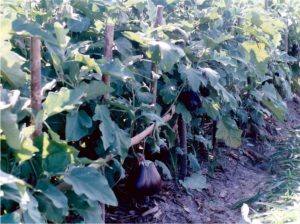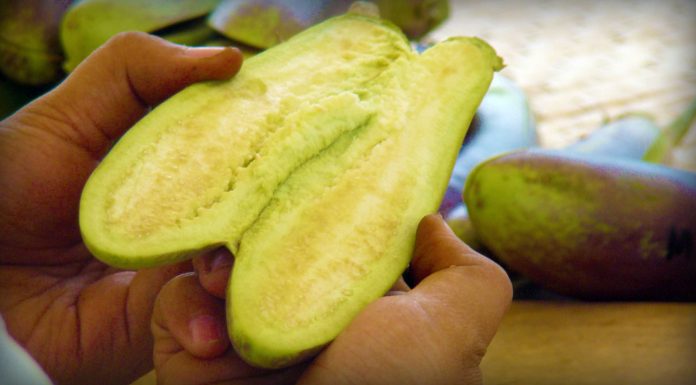Housewife Saturnina Dela Rita from Bansalan, Davao del Sur loves cooking eggplant. Today, she slices about five pieces of eggplant and mixes it with other vegetables. She’s preparing “pinakbet,” the favorite dish of her son.
Yesterday, Saturnina grilled 10 eggplants. Once cooked, she peeled them off and placed them in a saucer that was full of beaten eggs with salt. In a prepared fan, she fried the eggplant. After cooking, she brought them to the table where her daughter, Gerry, was waiting. He ate the eggplant omelet with much gusto.
But what the family really like is the fresh eggplant salad. Saturnina boils about 8 eggplants in a hot water, then mashes them. After that, she pours some vinegar and soy sauce. It is served with onions and tomato.
“I can cook eggplant in various ways,” Saturnina says. “But the big problem I have with this fruit vegetable is that some of them have worms inside them. My children abhor seeing worms in already cooked eggplant.”
Saturnina may no longer has that problem soon. Thanks to Bt talong which farmers will be planting once it is already approved for commercialization. Currently, it is undergoing some studies to ensure that it passes through many tests and safety assessments.
Bt stands for Bacillus thuringiensis and talong is the local term for eggplant. Bt talong is a product of modern biotechnology thus it is also called genetically modified (GM) crop. Biotechnology, as defined by the Convention on Biological Diversity, is “any technological application that uses biological systems, living organisms, or derivatives thereof, to make or modify products or processes for specific use.”
In traditional, non-genetic engineering form, biotechnology has already brought in a lot of benefits. But modern biotechnology has allowed scientists to further enhance what the nature has already done.
“Bt talong was developed by genetically engineering a gene from the bacteria so that the GM eggplants now produce a protein that defends it against insect attacks,” explained Dr. Michael Purugganan, a Filipino plant geneticist who is the Dean of Science at the New York University.
 Bt, a common soil bacterium, produces a protein that paralyzes the larvae of some harmful insects, including the eggplant fruit and shoot borer (EFSB). Scientifically, it is called Leucinodes orbonalis, a moth specie prevalent in Asia and Africa.
Bt, a common soil bacterium, produces a protein that paralyzes the larvae of some harmful insects, including the eggplant fruit and shoot borer (EFSB). Scientifically, it is called Leucinodes orbonalis, a moth specie prevalent in Asia and Africa.
A briefing paper published by the International Service for the Acquisition of Agri-biotech Applications (ISAAA) gives this bit of information: “Female moths deposit eggs mostly on eggplant leaves. Upon hatching, the young larvae, after an hour or two of probing, feed on the leaf tissues and tunnel inside shoots, resulting in wilting or drying up. When the fruits are available, the caterpillar bores inside the fruit, producing feeding tunnels. This makes the fruits unfit for market.”
EFSB feeds almost exclusively on eggplant. An entire crop can be lost from EFSB infestation. “The EFSB can cause as much as 50-75% loss of fruits,” said former Science Secretary Emil Q. Javier.
The current methods used by some eggplant growers in controlling the EFSB, however, are unacceptable, said Dr. Emiliana Bernardo, a member of the Department of Agriculture’s Scientific and Technical Review Panel which reviews and assesses the safety of gene modified foods.
Many eggplant farmers spray chemical insecticides every other day, or up to 80 times per growing season to control EFSB infestation in their farms, pointed out Dr. Bernardo, an entomologist or a scientist who studies insects.
But the use of insecticide is effectively only against newly-hatched EFSB. Other than chemical sprays, some farmers apply different methods to control the pest, among them: following regular crop rotation or intercropping the eggplant with other vegetables; using nylon net barriers to protect plants from the insects; trapping male insects using pheromones to prevent insect mating; growing eggplants in a screenhouse before transplanting into the field; using judicious pesticide to keep populations of natural enemies of EFSB; and harvesting fruits regularly.
Most of these methods, however, are not 100-percent effective and labor intensive. Intensive pesticide use, on the other hand, often leads to environmental and health issues aside from increases the total production costs.
Unfortunately, there is no known genetic resistance to EFSB in cultivated and wild eggplants. “The insects are concealed in the shoots and fruits and are difficult to reach,” said Dr. Javier, who is the president of the National Academy of Science and Technology.
One possible solution is to introduce Bt into the vegetable crop, thus giving birth to Bt talong. “When ingested by the larvae of the target insect, the Bt protein is activated in the gut’s alkaline condition and punctures the mid-gut leaving the insect unable to eat. The insect dies within a few days,” the ISAAA briefing said.
Bt is present in the Philippine soil and had been in use for years without any harmful effects. As it comes from the earth itself, Bt is very natural, according to Dr. Bernardo. In 1901, Bt was discovered to have an insecticidal property. By 1950s, it became a well-known biological insecticide.
“Bt is easily cultured by fermentation,” the ISAAA briefing paper said. “Thus, over the last 40 years, Bt has been used as an insecticide by farmers worldwide. Organic farming has benefited from Bt insecticide, as it is one of the very few pesticides permitted by organic standards. The insecticide is applied either as a spray or as ground applications. It comes in both granules and liquefied form.”
Edgar Talasan is an eggplant grower from Impasug-ong, Bukidnon. He is batting for the growing of Bt talong among Filipino farmers. “I tried the organic farming system, the system of crop rotation and fallowing as well as the application of integrated pest management but the organic system does not provide as much yield as Bt eggplant (would give), while the other systems are labor-intensive and cumbersome.”
Meanwhile, the first-ever field study of Bt talong reported that “no negative impacts on the biological diversity of non-target organisms.” It is consistent with previous studies on insect-resistant Bt crops such as cotton and corn.
Dr. Anthony Shelton, international professor of entomology at Cornell University and co-author of the study, commented: “This study confirms the environmental safety of Bt eggplant to non-target organisms under field conditions in the Philippines. Our previous study documented the effective of Bt eggplant against the destructive eggplant fruit and shoot borer. Combined, these studies clearly document the benefits of Bt eggplant to growers, farm workers, consumers and the environment.”
Bt talong is not commercially available. But once it is approved, seeds will be made available to farmers. Eggplant production in the country covers approximately 22,000 hectares.
But the big question is: Is the Bt protein found in Bt talong safe to non-target organisms? On tests conducted on dogs, guinea pigs, rats, fish, frogs, and even birds, the Bt protein was found not to have any harmful effects, according to Extension Toxicology Network (Extoxnet), a pesticide information project of several US universities.
“The specificity of Bt for its target insects is one of the characteristics that make it an ideal method of biological pest control,” the ISAAA briefing paper said. “The specificity rests on the fact that the toxicity of the Bt protein is receptor-mediated. This means that for an insect to be affected by the Bt protein, it must have specific receptor sites in its gut where the proteins can bind. Fortunately, humans and majority of beneficial insects do not have these receptors.”
According to Dr. Bernardo, cooking the Bt talong can completely denatured the Bt protein. “It is non-detectable in any cooked food therefore there is no human exposure to Bt proteins in eating cooked Bt crops,” she said.
On the other hand, the US Environmental Protection Agency has already administered toxicology assessments, and Bt proteins have already been tested at relatively higher dosages.
Here’s what the Extoxnet said in its report: “No complaints were made after 18 humans ate one gram of commercial Bt preparation daily for five days, on alternate days… Humans who ate one gram per day for three consecutive days were not poisoned or infected.”
If that is not comforting enough, here’s what the GM Science Review Panel of the United Kingdom says about GM crops: “For human health, to date there is no evidence currently commercialized GM crop varieties or foods made from them, are toxic, allergenic or nutritionally deleterious. On balance, we conclude that the risks to human health are very low for GM crops currently on the market.”







